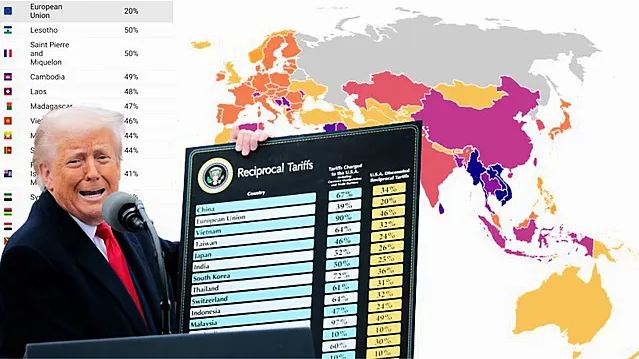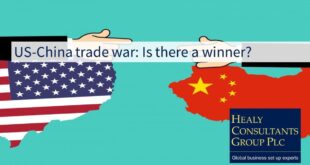The world watches, aghast, as a single politician’s actions threaten to plunge it into chaos. On April 2nd, 2025, Donald Trump’s “presidential tariffs” descended upon over 90 nations, a declaration of economic warfare framed as a righteous correction. “Many countries have ripped us off left and right,” he proclaimed, framing America, the world’s economic titan, as a victim of global exploitation. “But now, it’s our turn, to do the ripping.” You can read more about Trump’s Tariff Tempest: A World on the Brink.
The immediate consequence was a global market crash, trillions of dollars evaporating within a week, and the specter of a global recession looming large. “The world taters on the edge of a potential global recession,” the transcript warns. Monday, April 7th, became a day of universal financial dread, with stock markets plummeting from Hong Kong to India, Germany to the US.
The handling of this crisis is described as “strange and childish,” epitomized by a rapid-fire escalation with China. Trump’s initial 34% tariff on Chinese goods was met with an equal retaliation, prompting a threat of a further 50% increase. “If the tariff isn’t removed by tomorrow at 12 o’clock, we’re putting a 50% tariff on above the tariffs that we’ve put on,” he declared. China, however, remained resolute, leading to a tit-for-tat escalation of 125% tariffs on both sides. This trade war, the transcript asserts, is now impossible to ignore.
Returning to the tariffs, the transcript provides a fundamental explanation: tariffs are taxes imposed on imported goods. Examples include the 15% import tax on iPhones in India and the 20-25% duty on clothing. The primary purposes are to generate government revenue and protect local industries by making foreign goods more expensive.
The case of South Korea illustrates the potential benefits of strategic tariffs. During the 1980s and 1990s, tariffs protected South Korean farmers from cheaper imports, allowing them time to adopt modern technology and become globally competitive. Had tariffs not been implemented, the transcript argues, the local farming sector would have collapsed, leading to widespread poverty and unemployment.
However, the transcript emphasizes that the manner in which tariffs are imposed is crucial. Unilateral and sudden tariffs, like those enacted by Trump, can trigger retaliatory measures and escalate into a trade war. The importance of negotiation and mutual agreement is highlighted.
Trump’s actions are characterized as reckless and devoid of consultation. “We’re gonna have to go through a little tough love, maybe,” he reportedly stated. “They all understand. They’re ripping us off and they understand it.” This approach, the transcript argues, has predictably led to widespread retaliation.
Trump’s stated justification for the tariffs is to reduce America’s trade deficit, which he deems a “national emergency.” He defines trade deficit as the difference between a country’s exports and imports, using the example of a $1 billion deficit with China. However, the transcript counters that a trade deficit is not inherently detrimental, particularly for a strong economy with significant foreign investment.
The specifics of Trump’s tariffs are presented with a sense of disbelief. A “big board” displayed tariffs of at least 10% on virtually all imported goods, including those from countries with which the US did not have a trade deficit. He also justified some tariffs as “reciprocal,” claiming they mirrored existing tariffs imposed by other countries.
The list of tariffs is extensive: 49% on Cambodia, 46% on Vietnam, 20% on the EU, 32% on Taiwan, 25% on South Korea, 26% on India, and 17% on Israel. The 125% tariffs imposed on China, and reciprocated by China, are the culmination of the escalating conflict.
The formula used to calculate these tariffs is presented as absurdly simplistic: the trade deficit divided by imports, with half of the resulting percentage becoming the tariff. This formula, the transcript argues, was misapplied, with Trump incorrectly claiming the result represented existing Chinese tariffs.
The most bizarre aspect of Trump’s tariffs, according to the transcript, is their application to uninhabited islands near Antarctica. Heard Island and McDonald Island, home only to penguins and accessible only by a two-week boat journey, were subjected to a 10% tariff.
The real-world consequences of these tariffs are significant. America’s vast consumer market means that businesses worldwide rely on selling goods to American consumers. Retaliatory tariffs from China, the EU, and Canada have targeted sectors crucial to Trump’s voter base, such as corn farmers, carmakers, and steel mills.
The transcript argues that Trump’s tariffs will ultimately harm Americans the most, given the globalized nature of modern production. Even products labeled “Made in America” often rely on imported raw materials, as exemplified by Mr. Beast’s chocolates.
Historical precedents are invoked to illustrate the potential dangers of protectionist policies. The Tariff Act of 1789, the McKinley Tariff of 1890, and the Smoot-Hawley Tariff Act of 1930 are cited as examples of tariffs that led to economic downturns and global trade decline.
The transcript highlights America’s post-World War II advocacy for free trade and the establishment of the WTO, an organization dedicated to reducing tariffs. Trump’s actions, it argues, have undermined this long-standing policy and eroded international trust in America.
A statement by the Prime Minister of Singapore is quoted, drawing parallels between the current trade war and the events leading up to World War II. “Trade war escalated to armed conflicts and eventually the Second World War,” he warns, highlighting the unpredictable and dangerous nature of the current situation.
The transcript concludes with the news of Trump’s 90-day pause on tariffs for all countries except China, coupled with a reduction to 10%. This sudden reversal, the transcript suggests, has further fueled confusion and distrust. The possibility of stock market manipulation is raised, with Trump’s pre-announcement tweet urging followers to “buy!!!” coinciding with a market surge.
The transcript offers two possible explanations for Trump’s actions: either he underestimated the global backlash or he is engaged in a complex strategy to “trap” China. Both scenarios, it argues, demonstrate his incompetence and disregard for the global consequences of his actions. The analogy of “trying to kill a cockroach by setting fire to the house” is used to illustrate the destructive nature of his policies.
 ODosta Inc. Create Your Own Tech World
ODosta Inc. Create Your Own Tech World









